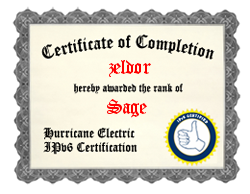I think you have heard already of IPv4 address depletion. A new version of Internet addressing (New Internet protocol) system was prepared many years ago. But since everyone was using IPv4 address, the migration has not been implemented in a large scale. If we continue to use IPv4 address as on today, the entire range would be used up in less than one years. (Hurricane-Electric has a very nice counter.) Public IPv4 addresses are mainly used by Internet servers. Other PCs or Servers can use private IPv4 address which are not reachable from Internet. Although many methods like NAT (Network Address Translation) and CIDR (Classless Inter Domain Routing) were implemented to stretch the IPv4 address usage, it seems that it is reaching a level of saturation now.
It is sure that everyone must migrate to IPv6 address within a couple of months/ years. Some Internet registries are not so liberal in assigning free IPv4 address now. If you want to learn about IPv6 and make sure that you have skills to administer IPv6 address and servers, Hurricane Electric free IPv6 certification is a really great way to begin. You can register for this certification at: he.net. I will give you a brief overview of the tests in the following section.
Through this test set you will be able to:
-> Prove that you have IPv6 connectivity
-> Prove that you have a working IPv6 web server
-> Prove that you have a working IPv6 email address
-> Prove that you have working forward IPv6 DNS
-> Prove that you have working reverse IPv6 DNS for your mail server
-> Prove that you have name servers can respond to queries via IPv6
-> Prove your knowledge of IPv6 technologies through quick and easy testing
There are seven levels of certification available. The breakdown of each are given below:
Newb: Read the primer stuff, be able to answer some quick and easy questions.
Explorer: Verify that you can access ipv6.he.net over IPv6
Enthusiast: Verify that you have an IPv6 capable web server that we can connect to and fetch information from. This should be entered as a FQDN and not an IPv6 address, or you will have issues once you start working on the Guru level.
Administrator: Verify that you have a working IPv6 capable MTA by sending you an email only over IPv6.
Professional: Verify that your MTA has working reverse DNS (ex: dig mx $domain +short ; dig AAAA $mx +short ; dig -x $mx AAAA +short)
Guru: Verify that the authoritative NS for your domain have AAAA records, and respond to queries for the domain (ex: step 1 is dig ns $domain ; dig AAAA $ns | step 2 is dig AAAAA $domain @$nsAAAA)
Sage: Check to see if your domain’s authoritative NS have IPv6 glue with their listed TLD servers. Meaning the TLD server can directly answer for the host record (ex: dig +trace ns $domain to get the TLD server list then dig aaaa $ns @TLD +short for the glue).


